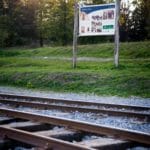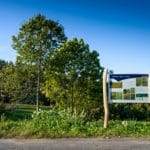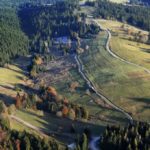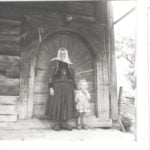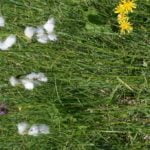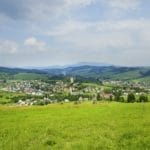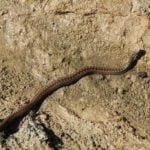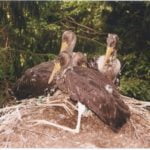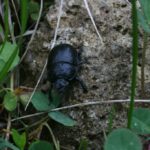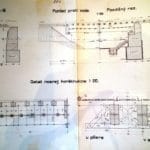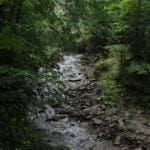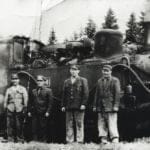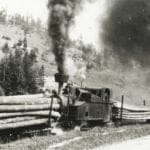Educational trail
Orava Museum of P. O. Hviezdoslav in Dolný Kubín prepared an educational trail in the area of the Orava Forest Railway to introduce the natural, cultural and historical heritage of the region to its visitors. The trail is situated right by the railway track in the astonishing nature of the villages Oravská Lesná and Zákamenné, and apart from its educational purposes, it can also serve as an alternative road for hikers and cyclists. Estimated time spent on the trail is from 1 to 2 hours.
Individual points of interest are marked with information boards that focus on the history of the Orava Forest Railway, everyday life of the local people and natural treasures of the region in the following eight topics: Switchback system of the Orava Forest Railway, Gorals in Orava, Waterlogged meadows and peatlands, Traditional living, Wild animals, Technical aspects of the Orava Forest Railway, Forests and Concise history of Orava Forest Railway. English versions of the texts can be accessed by scanning QR codes present on each individual board.
1. Switchback system of the Orava Forest Railway
Orava Forest Railway was built in 1918 in the possessions of Orava Compossessorate, specialized in the wood industry and sale. Compossessorate’s intention was to construct a railway that would transport timber from an inaccessible mountainous terrain. The original railway led from the village of Lokca to Oravská Lesná. However, the railway had no direct connection to the main public railway network. Out of three suggested variants, the connection with the narrow-gauge railway in Kysuce region was chosen as the most sufficient and affordable one. The biggest technical obstacle the connection was facing was the Beskyd Saddle on the border between Orava and Kysuce, with its height of 935 metres above the sea level. The steep terrain of the saddle was definitely a challenge for the railway designers. In order to prevent the building of expensive viaducts or tunnels, a switchback system, also called a zig-zag, was accepted as the right solution in 1925. The railway was planned and designed by the company of dipl. Ing. Edmund and Ladislav Gál from Ružomberok. In 1926, the connecting section using five switchbacks was completed and the Orava-Kysuce Forest Railway was in operation.
The switchback system was a technically creative solution of the super elevation problem; it used a pendulum-like redirection of a V-shaped track, where two tracks would meet in one in a switchback. A train would arrive to the switchback by one side but would leave by moving backwards. This would use the locomotive’s ability to pull and to push (to move forwards and backwards). The switchbacks would therefore effectively reduce the ascent angle of the terrain without building expensive and technically more demanding tunnels or viaducts.
Three switchbacks are direct parts of the track, remaining two switchbacks are built in the Beskyd Saddle Station and Chmúra Station. The first switchback is at Beskyd Saddle Station which is also the only switchback at the Orava side of the railway. The switchback is located at the highest point of the railway. The switchback system of the railway, built in 1926, is a unique technical and historical monument.
2. Gorals in Orava
Specific development of the Goral culture in Orava was determined by the historical, social and economic conditions during the Wallachian colonisation in the second half of the 15th century. Goral identity is represented mainly by the Goral dialect which is considered to be of a Polish origin. In several locations, such as the Námestovo district, the clothing made from linen, broadcloth, fur, leather and other domestic materials became a distinguishable feature of the Goral population. It had a simple shirt-like design in order to be comfortable for work in the fields or the forests.
The villages of Upper Orava were known to be relatively densely populated, however, the climatic conditions were not suitable for farming. The inhabitants were therefore forced to travel abroad and earn a living elsewhere. Some left for good, some were leaving seasonally. The seasonal employment outside the region was then reflected in the material and spiritual culture of Beskydy Gorals.
In the traditional Goral culture, annual and family rituals played an important role. These are still kept alive either by the families themselves, or by folk collectives that spread the culture outside the region. Specific Goral expression and customs enrich the diversity of the Orava folk culture. From the ethnic point of view, Gorals in Slovakia are considered to be of a Slovak ethnicity.
3. Waterlogged meadows and peatlands
The waterlogged meadows and peatlands are one of the characteristic elements of the natural environment. Their existence is determined by a sufficient soil moisture throughout the year, slight fluctuations of water in the soil and regular maintenance (mowing, grazing).
The high species of herbs and grasses, e.g. meadow foxtail, meadow fescue and brook thistle, can be found in the top layer of the herbal level. The middle layer is more diverse. Hydrophilic species grow in this layer, e.g. marsh marigold, meadow pea, cuckooflower, or bistort. Gladiolus is also typical for this layer. In sufficient ecological and maintenance conditions, the medium soil moisture species such as Seneca grass, moon-daisy, ribgrass and several species of a water spring area can appear. However, in many places, mosaic-type species are common, e.g. black sedge, common cotton-grass, broad-leaved cotton-grass and several orchid species such as western marsh orchid, marsh helleborine, lesser butterfly orchid, lesser twayblade, globe orchid and fragrant orchid. In small amounts, marsh lousewort appear as well.
The appearance of the plant community changes over the year, depending on the predominant species in a given season. In spring, meadows are full of lady’s smock or meadow buttercup, while the damper places host marsh marigold and western marsh orchid. The shape and colour diversity of the brook thistle, cotton-grass and orchid attract attention especially in June and at the beginning of July. The value of the waterlogged meadows and peatlands is underlined by the fact that they belong to the biotopes of national and European importance. Several species growing in these areas are also protected by the law.
4. Traditional living
In 11 locations on the Slovak-Polish border in the northern Orava, an ethnographic group of Orava Gorals resides. Their strong dialect remains the most distinctive feature. The name “Goral” translates as “the mountain man” – corresponding with their mountainous origin, predominantly bound to the Beskydy Mountains. Their original dwellings, scattered around the mountains, can be described as one-room residential houses with a barn and a stable under one roof, insulated from the north and the north-west by a wooden board construction.
The main occupation of the Goral community was farming and shepherding. To earn a living, harvesting was an important, with the mushroom picking still being practised. Hunting culture also played a significant role, mainly in the form of forest beekeeping or game and fish hunting.
Timber logging and its consequent selling was practised as a side source of income. Homemade production was mainly focused on shingles and household kitchenware, sometimes clothes and shoes production appeared as well. Blacksmithing and wheelmaking were also significant.
Climatic conditions and soil quality in the region were not in favour of the agricultural lifestyle, and the inhabitants were therefore forced to travel abroad – some for good, some were leaving seasonally.
5. Wild animals
The fields, pastures, meadows and wetlands of the region’s specific nature support the diversity of the animal species living in this area, with some of them being protected by the law. The basis of any natural environment are insects, such as ground beetles, scavenger beetles, traders, green tiger beetles, chain pellets or dung-beetles. These play an important role of keeping the biological balance. Apart from the numerous species of orthoptera, many species of grasshoppers and butterflies can be found. Bigger animals appearing in this area are represented by Carpathian deer, roe deer, wild boars, foxes, bears, wolves and lynxes. In the aquatic environment, Eurasian otters, brown frogs, European toads, yellow-bellied toads and also several newt species can be found.
The species of birds of prey, such as grey-faced buzzards, goshawks and falcons, nest in this area, as well as golden eagles, lesser spotted eagles, Ural owls and others. In mountainous regions, black grouses or more frequently occurring hazel grouses reside. The scrublands host the families of green singing-finches, European turtle doves, red-headed buntings, common skylarks, great tits and other small songbirds. Of the rarer species, peewit and corn crake can be spotted.
Many of the abovementioned species are seriously endangered by the negative effects of human activities and therefore the protection and sensitive approach to their natural habitats is needed.
6. Technical aspects of the Orava Forest Railway
Forest railways were often used to solve the problem with timber transport from inaccessible mountainous areas. At the turn of the 19th and 20th century, the more efficient rail transport was used much often than the first cars or teams of horses on forest roads that were dependent on the weather. Waterway transport was also proven unreliable in not suitable climatic conditions. In Austria-Hungary, at the end of the 19th century, smaller railways with a track gauge of 1000, 760 and 600 mm were often put to use. These were not only smaller but also cheaper and their construction was more than suitable for the mountainous terrains, as well as the light rail vehicles that ran on the tracks. Thanks to this, Orava Compossessorate – the initiator of the construction of the Orava Forest Railway, decided to use this type of railway with a gauge of 760 mm.
The track consisted of two rails with wooden sleepers between them, covered by grit. The construction technology was therefore very similar to standard railways, with bridges used to overcome water obstacles. These had brick foundations when bigger, otherwise wood was used. The maximum speed limit was 20 km/h and the transport of people was not allowed, except for the employees.
The 22,6 km long track of the Orava Forest Railway, completed on July 27 in 1918, started in the village Lokca and headed to Oravská Lesná through the valley of the Biela Orava river. The railway had two side-tracks, one 14,4 km long heading to the village Mútne through the valley of the Mútňanka river, while the second one with 4,4 km in length left in Juríková. More than 8 km long line connecting the Orava railway with another forest railway in Kysuce through the Beskyd Saddle, was completed on October 10, 1926. The Kysuce railway used the system of five switchbacks that helped to solve the problem with the super elevation of 217,69 m, without building any expensive viaducts or tunnels.
The length of the main line between Lokca and the Beskyd Saddle was 31,825 km, while the total length of the connected Orava-Kysuce Forest Railway was 60,849 km. The Orava side of the line was interconnected with six turn-offs. The first side-track to Lokca was terminated in 1931. The second track led to the Oravice part of the village Zákamenné where the steam sawmill was located. Úšust I, the third side-track, was built in 1924. The Juríková – Vysoká Magura track was the fourth branch, built with the main line and extended between the Úšust and Vysoká Magura Mountain in 1924. The section between Ústrig and Gontkula became the part of the main line in 1925, the rest of the side-track disappeared in 1928. The Mútne – Furandová turn-off was also built with the main line. It originally started in the village Breza and ran through the valley of the river Mútňanka, however, in 1924, the side-track was extended from the switch at Ďadový Bor. The turn-off was terminated in 1968. The last branch was the Podrusnácka track, built in 1918 as a part of the main line between Lokca and Oravská Lesná. After the construction of the connecting track, it became a turn-off at Ústrig. This branch was in operation until the railway liquidation.
7. Forests
The durability and longevity of forests make them the most stable environment in any area. Here, the original pine grove and beechwood have been rarely preserved, except for the transition areas between acidic spruce forests and deciduous forests. These consist of spruce, fir, beech and rowan. In higher altitudes, the forests gradually turn into the mountain beech and spruce forests. Maple tree, European ash, wild cherry, small-leaved lime, birch, willow, populous and alder appear in damp woodlands.
In case of shrubs, raspberries, blackberries, blueberries and cranberries are often to be found. Scrublands are composed of European elder, highbush cranberry, common hazel, blackthorn, hawthorn and dog rose.
Forests are ideal for the growth of mushrooms. Several species of edible mushrooms, red cracking boletes and rough-stemmed boletes, as well as some inedible species such as ruby bolete or bitter bolete, are often picked. Fly agaric, saffron milk cap, rosy russula, wood blewits, naked mushrooms, cortinars and button mushrooms can be found here as well. The rotting timber is often covered with red belt conk, tinder fungus and many types of rusty gilled polypore, stereum and tramenes. Club coral, pig’s ears and catathelasma can be spotted at the edge of spruce forests.
Gradual degradation and dying of forests cause changes in their composition and weaken their resistance to diseases, biological pests, adverse climatic conditions and human activity. Therefore, it is important to understand the forest environment in order to protect it for future generations.
8. Concise history of Orava Forest Railway
Orava Compossessorate planned a construction of the Orava Forest Railway in order to transport timber from their forests to customers. In 1918, the construction of the railway from the village Lokca to Oravská Lesná was prepared and realized by Nagy és Radó Company from Budapest. During the course of the construction at the time of the First World War, a labour force of Italian prisoners of war was used. Railway administration, train depot and locomotive shed were built in Lokca. However, the newly constructed railway had no direct connection to the public railway network. Several variants were suggested and finally, the idea of connecting the railway with a similar forest railway in Kysuce region arose. Company of Ing. Edmund and Ladislav Gál from Ružomberok worked out a plan of connection with the Kysuce Forest Railway in 1925 and the year after, the construction began. Since the railway ran to Kysuce, the train depot and locomotive shed in Lokca were closed in 1931 and replaced by the new ones built in Zákamenné. The railway was in operation even during the Second World War. It was damaged during the Slovak Nation Uprising but after the end of the war, it was repaired and put back to use.
The end of the Second World War marked the dissolution of Orava Compossessorate. Its possessions, including the forests and the Orava-Kysuce Forest Railway, were passed to the ownership of the Czechoslovak State Forests. The administration of the railway was entrusted to Zákamenné Forest Works. Using the forest railway as a public transport was planned after the war, however, the railway was eventually used for timber transportation only, with the 50s being the busiest decade. This was all halted after the flood in 1965, when the railway was severely damaged and in 1967, it was officially liquidated and gradually dismounted. Fortunately, there was a consent to preserve the switchback section of the railway as an object of technical and historical importance and in 1974, the Kysuce part of the railway was taken to administration of Kysuce Museum in Čadca.
After long disputes, the Orava part of the railway passed to the administration of Orava Museum of P. O. Hviezdoslav in 1988. In 1991, preserved parts of the Kysuce and Orava forest railways were named National Cultural Monuments. In the following year, Orava Museum of P. O. Hviezdoslav and Kysuce Museum in Čadca agreed on the restoration works. On the Orava side, the area of Beskyd Saddle and the bridge near Tanečník Station were thoroughly reconstructed by the Railway army of the Armed Forces of the Slovak Republic.
New revitalization program was conceived by Orava Museum of P. O. Hviezdoslav in 2004. Track restoration plan was prepared by Ing. Ján Špánik and Ing. Roman Ličko from Reming Consult a.s. Bratislava. INKOPP s.r.o. Žilina was responsible for object restoration. The revitalization was financed from the EU project “Realising the potential of Upper Orava in tourism by revitalization of the Orava-Kysuce Forest Railway connecting the regions of Orava and Northern Považie” in 2005. The restoration works were realized by KOTEZA s.r.o. Vrútky between the years 2005 – 2007. On May 31, 2008, the Orava Forest Railway was officially opened to the public, with the trains running from Tanečník Station to the Beskyd Saddle and back. Exhibition “The Past and the Present of the Orava Forest Railway” was also opened that year in the area of Tanečník Station.




